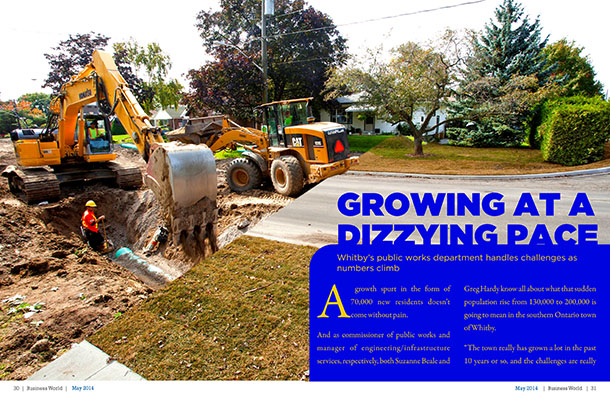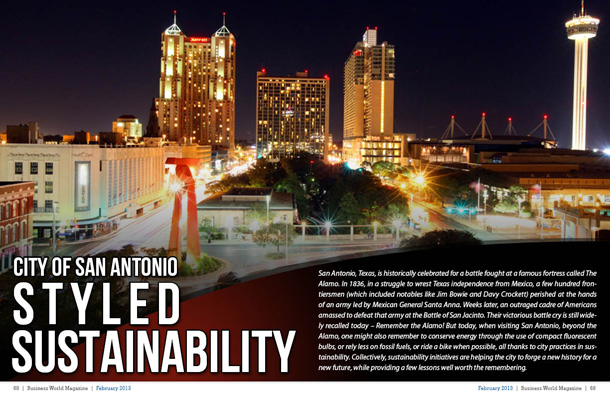
Growing at a Dizzying Pace
Whitby’s public works department handles challenges as numbers climbÂ

A growth spurt in the form of 70,000 new residents doesn’t come without pain.
And as commissioner of public works and manager of engineering/infrastructure services, respectively, both Suzanne Beale and Greg Hardy know all about what that sudden population rise from 130,000 to 200,000 is going to mean in the southern Ontario town of Whitby.
“The town really has grown a lot in the past 10 years or so, and the challenges are really just dealing with all the infrastructure requirements that go with the growth,†Beale said.
“To service all the new population. We’ve had some lessons learned in terms of keeping up and we know what some of the challenges have already been.â€
Indeed, a statistical uptick is not something with which Whitby is wholly unfamiliar.
The town’s population at the time of the 2001 census was 87,413, before a 27.2-percent spurt brought it to 111,184 residents by 2006. Just five years later, in 2011, the number had swelled another 9.7 percent to 122,022, and the 200,000 threshold could be breached as soon as 2030.
That, incidentally, would be a 63.9-percent ascension from 2011.
And while slow, steady growth presents one set of issues for municipal employees in similar lines of work, Hardy said the “burst†brand of growth in Whitby has its own unique characteristics.
“It’s great for a municipality, but it’s a challenge from an asset management perspective,†he said. “Great big waves of infrastructure were created all at once, but then ultimately we have to maintain those assets and there’ll be a big wave that will be needing renewal at the same time.â€
One way to combat the challenges is with a specific emphasis on sound planning.
Beale and Hardy said that Whitby has been particularly successful in its growth, thanks to a town council that’s understanding of public works realities and processes put in place over the last five to seven years through which needs are anticipated and accommodated before they reach crisis stage.
Hardy said actions are being taken – in the form of a secondary plan and a transportation master plan – that deal with expected changes coming to the town’s northern section of Brooklin.
The secondary plan will address land-use designations for the urban expansion areas to the north and west, the industrial lands adjacent to the future Highway 407 and lands in the vicinity of the Conlin Road/Anderson Street intersection, as well as an update to the Brooklin Community Secondary Plan.
The transportation master plan will determine transportation infrastructure and mobility requirements and will be conducted alongside the Municipal Engineers Association’s class environmental assessment. The work already completed for the northwest Brooklin assessment – to address concerns regarding Highway 7/12 as it passes through downtown and gaining care and control of Baldwin Street as it passes through Brooklin – will be incorporated into the master plan.
Also on Hardy’s plate is assembling a town-wide asset management strategic plan to manage the increasing levels of service. Phase one looks at roads, bridges and sidewalks – what he called the “big-ticket, high-value†assets for public works – and determines what the amounts of funding will need to be to sustain those services over the next 25, 50 and 100 years.
“Quite honestly, we’re pretty close,†he said. “There are some funding shortages, but, since we started quite a few years ago, those assets are in pretty good shape.â€
The next phase of the plan will examine what the expected life-cycle costs of existing assets are, and determine a sustainable amount of funds needed for the short, medium and long terms.
The overall foresight mentality, Beale said, comes at least partly from a departmental survey several years ago that showed the town’s roads were “going to fail terribly†within the next 10 years, and that the department “didn’t have near the money to deal with it.â€
A subsequent presentation before the council illustrated those realties in no uncertain terms over a 50-year stretch, which prompted conditional buy-in with the proviso that she and her colleagues would report back each year with a progress report on how the money was being spent.
“We’ve been pretty fortunate,†Beale said. “We have really gotten council’s buy-in in terms of understanding that, if you buy a car, you have to maintain it. The same thing applies if you build a road. You’re going to have that asset for 25 years, and you have to be able to maintain it. So having that mindset of you’re not just building something, you’re going to own it for the rest of its life.â€
The next population game-changer will come on completion of the extension of Highway 407, which is also being done in two phases. Phase one, now under way, includes the main line from Brock Road in Pickering to Harmony Road in Oshawa and the West Durham link in Whitby. Phase two includes the main line from Harmony Road to 35/115 in Clarington and the East Durham Link in Clarington.
Phase one will be finished by late next year or early 2016, Hardy said, and phase two will be done by 2020 with an interim opening from Harmony Road to Taunton Road at the East Durham link by 2017.
“As soon as it’s constructed, I think you’ll see development occurring shortly thereafter,†he said.
Various Whitby entities are already at work, Beale said, in anticipation of the project’s impact – and the cascading effect will play out as time goes by and the completion date nears.
“We’ve got a development engineering group in public works, and they’re working on a lot of the plans,†she said. “It’s impacting different sections of public works, from an engineering perspective and a transportation perspective. It effects different parts of the department at different times.â€
Storm water management is another Whitby priority after significant flooding from major southern Ontario weather events since the arrival of the 21st century.
An erosion control study identified town locations in need of retrofitting and construction of new run-off ponds – and it’s now one of the few province-wide municipalities with a dedicated maintenance program for a roster of 40 ponds. Beale said several agencies are brainstorming to look at run-off patterns and how infrastructure can be put together to accommodate those findings.
That collegial concept is one that’s likely to be replicated as more growth spurts loom.
“In five years, we’re going to see a lot of the development, and it’s going to be smaller, more compact development intensification,†Beale said. “Some of our challenges will be, even from a maintenance perspective, in terms of how do we maintain? And when we have to rebuild that infrastructure, our technology may have to change. Some of our business model will change.
“It will be a bit of a different conversation.â€
AT A GLANCE
WHO: Town of Whitby
WHAT: Municipality of 130,000 residents in the Durham Region
WHERE: On the Lake Ontario shoreline in southern Ontario, about 56 kilometers northeast of Toronto and 10 kilometers west of Oshawa
WEBSITE: www.Whitby.ca
Â









What the supply jerseys richest Americans all have in common,supply jerseysThere are 513 bill customized nfl jerseys ionaires in America, according to Forbes, though only 400 of those make its annual list of the richest Americans. It’s ju wholesale nfl jerseys cheap st one of the many signs that the rich just keep getting richer. In fact, the wealth of the top 400 r
Comments are closed.